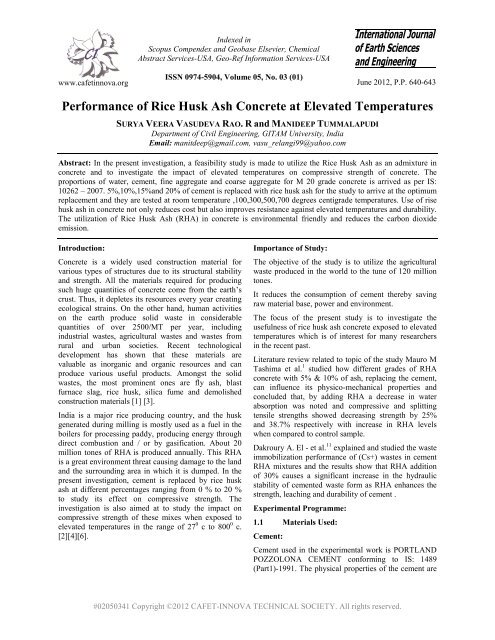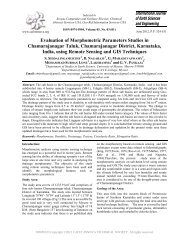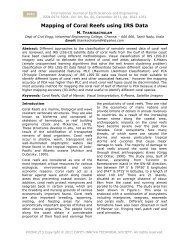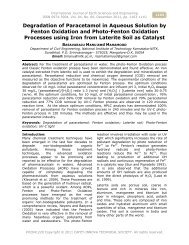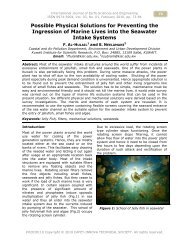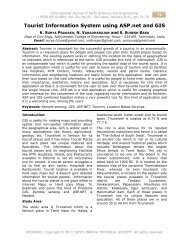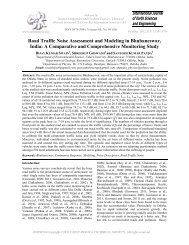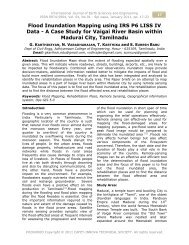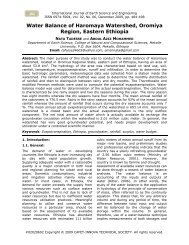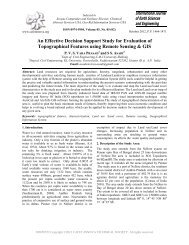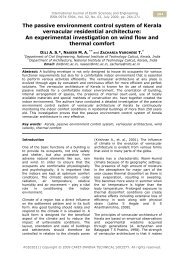Performance of Rice Husk Ash Concrete at Elevated ... - Cafet Innova
Performance of Rice Husk Ash Concrete at Elevated ... - Cafet Innova
Performance of Rice Husk Ash Concrete at Elevated ... - Cafet Innova
You also want an ePaper? Increase the reach of your titles
YUMPU automatically turns print PDFs into web optimized ePapers that Google loves.
www.cafetinnova.org<br />
Indexed in<br />
Scopus Compendex and Geobase Elsevier, Chemical<br />
Abstract Services-USA, Geo-Ref Inform<strong>at</strong>ion Services-USA<br />
ISSN 0974-5904, Volume 05, No. 03 (01)<br />
June 2012, P.P. 640-643<br />
<strong>Performance</strong> <strong>of</strong> <strong>Rice</strong> <strong>Husk</strong> <strong>Ash</strong> <strong>Concrete</strong> <strong>at</strong> Elev<strong>at</strong>ed Temper<strong>at</strong>ures<br />
SURYA VEERA VASUDEVA RAO. R and MANIDEEP TUMMALAPUDI<br />
Department <strong>of</strong> Civil Engineering, GITAM University, India<br />
Email: manitdeep@gmail.com, vasu_relangi99@yahoo.com<br />
Abstract: In the present investig<strong>at</strong>ion, a feasibility study is made to utilize the <strong>Rice</strong> <strong>Husk</strong> <strong>Ash</strong> as an admixture in<br />
concrete and to investig<strong>at</strong>e the impact <strong>of</strong> elev<strong>at</strong>ed temper<strong>at</strong>ures on compressive strength <strong>of</strong> concrete. The<br />
proportions <strong>of</strong> w<strong>at</strong>er, cement, fine aggreg<strong>at</strong>e and coarse aggreg<strong>at</strong>e for M 20 grade concrete is arrived as per IS:<br />
10262 – 2007. 5%,10%,15%and 20% <strong>of</strong> cement is replaced with rice husk ash for the study to arrive <strong>at</strong> the optimum<br />
replacement and they are tested <strong>at</strong> room temper<strong>at</strong>ure ,100,300,500,700 degrees centigrade temper<strong>at</strong>ures. Use <strong>of</strong> rise<br />
husk ash in concrete not only reduces cost but also improves resistance against elev<strong>at</strong>ed temper<strong>at</strong>ures and durability.<br />
The utiliz<strong>at</strong>ion <strong>of</strong> <strong>Rice</strong> <strong>Husk</strong> <strong>Ash</strong> (RHA) in concrete is environmental friendly and reduces the carbon dioxide<br />
emission.<br />
Introduction:<br />
<strong>Concrete</strong> is a widely used construction m<strong>at</strong>erial for<br />
various types <strong>of</strong> structures due to its structural stability<br />
and strength. All the m<strong>at</strong>erials required for producing<br />
such huge quantities <strong>of</strong> concrete come from the earth’s<br />
crust. Thus, it depletes its resources every year cre<strong>at</strong>ing<br />
ecological strains. On the other hand, human activities<br />
on the earth produce solid waste in considerable<br />
quantities <strong>of</strong> over 2500/MT per year, including<br />
industrial wastes, agricultural wastes and wastes from<br />
rural and urban societies. Recent technological<br />
development has shown th<strong>at</strong> these m<strong>at</strong>erials are<br />
valuable as inorganic and organic resources and can<br />
produce various useful products. Amongst the solid<br />
wastes, the most prominent ones are fly ash, blast<br />
furnace slag, rice husk, silica fume and demolished<br />
construction m<strong>at</strong>erials [1] [3].<br />
India is a major rice producing country, and the husk<br />
gener<strong>at</strong>ed during milling is mostly used as a fuel in the<br />
boilers for processing paddy, producing energy through<br />
direct combustion and / or by gasific<strong>at</strong>ion. About 20<br />
million tones <strong>of</strong> RHA is produced annually. This RHA<br />
is a gre<strong>at</strong> environment thre<strong>at</strong> causing damage to the land<br />
and the surrounding area in which it is dumped. In the<br />
present investig<strong>at</strong>ion, cement is replaced by rice husk<br />
ash <strong>at</strong> different percentages ranging from 0 % to 20 %<br />
to study its effect on compressive strength. The<br />
investig<strong>at</strong>ion is also aimed <strong>at</strong> to study the impact on<br />
compressive strength <strong>of</strong> these mixes when exposed to<br />
elev<strong>at</strong>ed temper<strong>at</strong>ures in the range <strong>of</strong> 27 0 c to 800 0 c.<br />
[2][4][6].<br />
Importance <strong>of</strong> Study:<br />
The objective <strong>of</strong> the study is to utilize the agricultural<br />
waste produced in the world to the tune <strong>of</strong> 120 million<br />
tones.<br />
It reduces the consumption <strong>of</strong> cement thereby saving<br />
raw m<strong>at</strong>erial base, power and environment.<br />
The focus <strong>of</strong> the present study is to investig<strong>at</strong>e the<br />
usefulness <strong>of</strong> rice husk ash concrete exposed to elev<strong>at</strong>ed<br />
temper<strong>at</strong>ures which is <strong>of</strong> interest for many researchers<br />
in the recent past.<br />
Liter<strong>at</strong>ure review rel<strong>at</strong>ed to topic <strong>of</strong> the study Mauro M<br />
Tashima et al. 1 studied how different grades <strong>of</strong> RHA<br />
concrete with 5% & 10% <strong>of</strong> ash, replacing the cement,<br />
can influence its physico-mechanical properties and<br />
concluded th<strong>at</strong>, by adding RHA a decrease in w<strong>at</strong>er<br />
absorption was noted and compressive and splitting<br />
tensile strengths showed decreasing strength by 25%<br />
and 38.7% respectively with increase in RHA levels<br />
when compared to control sample.<br />
Dakroury A. El - et al. 11 explained and studied the waste<br />
immobiliz<strong>at</strong>ion performance <strong>of</strong> (Cs+) wastes in cement<br />
RHA mixtures and the results show th<strong>at</strong> RHA addition<br />
<strong>of</strong> 30% causes a significant increase in the hydraulic<br />
stability <strong>of</strong> cemented waste form as RHA enhances the<br />
strength, leaching and durability <strong>of</strong> cement .<br />
Experimental Programme:<br />
1.1 M<strong>at</strong>erials Used:<br />
Cement:<br />
Cement used in the experimental work is PORTLAND<br />
POZZOLONA CEMENT conforming to IS: 1489<br />
(Part1)-1991. The physical properties <strong>of</strong> the cement are<br />
#02050341 Copyright ©2012 CAFET-INNOVA TECHNICAL SOCIETY. All rights reserved.
MANIDEEP TUMMALAPUDI and SURYA VEERA VASUDEVA RAO. R<br />
641<br />
obtained by conducting the tests specified as per IS:<br />
269/4831 and cement confirms to the requirements as<br />
per IS 1489-1991.<br />
<strong>Rice</strong> <strong>Husk</strong> <strong>Ash</strong>:<br />
<strong>Rice</strong> <strong>Husk</strong> <strong>Ash</strong> used in the present experimental study<br />
was obtained from Orissa. General specific<strong>at</strong>ions,<br />
Physical Properties and Chemical Composition <strong>of</strong> this<br />
RHA used in this study which are furnished by the<br />
supplier are given in Table-1, Table-2 and Table-3.<br />
[6][7]<br />
Fine Aggreg<strong>at</strong>e:<br />
Fine aggreg<strong>at</strong>e (sand) used in this experimental work<br />
confirms to zone III as per the specific<strong>at</strong>ions <strong>of</strong> IS 383:<br />
1970. The Specific gravity <strong>of</strong> the Fine aggreg<strong>at</strong>e is<br />
2.61.<br />
Coarse Aggreg<strong>at</strong>e:<br />
Crushed granite <strong>of</strong> 20 mm maximum size has been used<br />
as coarse aggreg<strong>at</strong>e. The sieve analysis <strong>of</strong> combined<br />
aggreg<strong>at</strong>es confirms to the specific<strong>at</strong>ions <strong>of</strong> IS 383:<br />
1970 for graded aggreg<strong>at</strong>es. The specific gravity <strong>of</strong><br />
coarse aggreg<strong>at</strong>e is 2.70.<br />
W<strong>at</strong>er:<br />
In this project potable w<strong>at</strong>er free from organic substance<br />
was used for mixing as well as curing <strong>of</strong> concrete.<br />
Super Plasticizers:<br />
Conplast SP430A2 complies with IS: 9103 and BS:<br />
5075 and ASTM-C-494 Type ‘G’ as a high range w<strong>at</strong>er<br />
reducing admixture for obtaining a workable mix.<br />
1.2 Mix Design for M20-Grade <strong>Concrete</strong>:<br />
The mix proportions arrived for M 20 grade concrete<br />
designed as per IS 10262 – 2007[8] are presented in<br />
Table -4. Cement in proportions <strong>of</strong> 0%, 5%, 10%, 15%<br />
and 20% is replaced with RHA.<br />
Tests Conducted:<br />
Standard 200 T compression testing machine is used for<br />
testing <strong>of</strong> samples <strong>of</strong> size 100*100*100 mm which are<br />
cast and cured for 28days,he<strong>at</strong>ed <strong>at</strong> different<br />
temper<strong>at</strong>ures for two hours. Specimens tested <strong>at</strong> room<br />
temper<strong>at</strong>ure i.e., 27degree centigrade are used for<br />
comparison purpose.<br />
Three each specimens <strong>of</strong> 0%,5%,10%,15%and 20%<br />
<strong>Rice</strong> <strong>Husk</strong> <strong>Ash</strong> replaced cubes are he<strong>at</strong>ed <strong>at</strong> temper<strong>at</strong>ure<br />
<strong>of</strong> 27 (Room Temper<strong>at</strong>ure),100,300,500and700 degree<br />
centigrade and their residual compressive strength are<br />
tabul<strong>at</strong>ed. The weight gain/loss is also noted for each<br />
sample and shown in figure below.<br />
Bogie Hearth Furnace supplied by M/s Industrial<br />
Furnace and Controls, Bangalore is employed to he<strong>at</strong><br />
specimens to different temper<strong>at</strong>ures. The he<strong>at</strong>ed<br />
samples are air cooled and tested for compressive<br />
Strength.<br />
Most concrete structures are designed assuming th<strong>at</strong><br />
concrete processes sufficient compressive strength but<br />
not the tensile strength. The compressive strength is the<br />
main criterion for the purpose <strong>of</strong> structural design. To<br />
study the strength development <strong>of</strong> <strong>Rice</strong> husk ash (RHA)<br />
concrete <strong>at</strong> elev<strong>at</strong>ed temper<strong>at</strong>ures in comparison to<br />
Control concrete, compressive strength tests were<br />
conducted <strong>at</strong> the ages <strong>of</strong> 7 and 28 days are reported as<br />
follows.<br />
Results and Discussions:<br />
1.3 General:<br />
The mix proportions along with test results presented in<br />
Table 5. Table 6&7 illustr<strong>at</strong>es Compressive strength<br />
development <strong>of</strong> Normal concrete and <strong>Rice</strong> husk ash<br />
concrete <strong>at</strong> different curing periods and <strong>at</strong> different<br />
elev<strong>at</strong>ed temper<strong>at</strong>ures. Compressive strength behavior<br />
<strong>of</strong> RHA concrete <strong>at</strong> elev<strong>at</strong>ed temper<strong>at</strong>ure designed by<br />
the replacement method are studied, where in the effect<br />
<strong>of</strong> age and percentage replacement <strong>of</strong> cement with RHA<br />
on Compressive strength is studied for M20 grade<br />
concrete and the slump <strong>of</strong> concrete is maintained <strong>at</strong> 75<br />
mm for all mixes.<br />
Conclusions:<br />
Based on the study carried out on the strength behavior<br />
<strong>of</strong> <strong>Rice</strong> <strong>Husk</strong> <strong>Ash</strong> Replaced <strong>Concrete</strong>, the following<br />
conclusions can be drawn:<br />
1. Replacement <strong>of</strong> RHA in the range <strong>of</strong> 5% to 20%<br />
does not change the compressive strength <strong>of</strong><br />
concrete. However, the workability decreases with<br />
the increase in RHA replacement level. To<br />
compens<strong>at</strong>e the loss <strong>of</strong> workability super plasticizer<br />
in the dosage <strong>of</strong> 10ml, 12ml, 14ml and 16 ml is<br />
required for 5%, 10%, 15% and 20% RHA<br />
replacement concrete respectively.<br />
2. The residual compressive strength <strong>of</strong> concrete for all<br />
the RHA replacements increases <strong>at</strong> the initial<br />
temper<strong>at</strong>ures <strong>of</strong> 100 0 c – 150 0 c and thereafter<br />
decreases gradually upto temper<strong>at</strong>ure <strong>of</strong> 700 0 c<br />
because pore w<strong>at</strong>er evapor<strong>at</strong>es <strong>at</strong> 100 0 c and the<br />
concrete m<strong>at</strong>rix becomes brittle.<br />
3. 15% replacement <strong>of</strong> RHA is found to be optimal as<br />
the residual compressive strength <strong>at</strong> various<br />
temper<strong>at</strong>ures in the range <strong>of</strong> 100 – 700 degrees<br />
centigrade shows similar strengths to th<strong>at</strong> <strong>of</strong><br />
concrete with out RHA <strong>at</strong> 28 days(as in fig1) .<br />
4. An overall performance <strong>of</strong> 10% RHA replacement<br />
level <strong>at</strong> both 7 and 28 days shows better residual<br />
compressive strength than th<strong>at</strong> <strong>of</strong> normal concrete<br />
and other replacements(as in fig1&2).<br />
Intern<strong>at</strong>ional Journal <strong>of</strong> Earth Sciences and Engineering<br />
ISSN 0974-5904, Vol. 05, No. 03 (01), June 2012, pp. 640-643
642<br />
<strong>Performance</strong> <strong>of</strong> <strong>Rice</strong> <strong>Husk</strong> <strong>Ash</strong> <strong>Concrete</strong> <strong>at</strong> Elev<strong>at</strong>ed Temper<strong>at</strong>ures<br />
5. By using this <strong>Rice</strong> husk ash in concrete as<br />
replacement the emission <strong>of</strong> green house gases can<br />
be decreased to a gre<strong>at</strong>er extent. As a result there is<br />
gre<strong>at</strong>er possibility to gain more number <strong>of</strong> carbon<br />
credits.<br />
6. The technical and economic advantages <strong>of</strong><br />
incorpor<strong>at</strong>ing <strong>Rice</strong> <strong>Husk</strong> <strong>Ash</strong> in concrete should be<br />
exploited by the construction and rice industries,<br />
more so for the rice growing n<strong>at</strong>ions <strong>of</strong> Asia.<br />
References:<br />
[1] P.ChandanKumar and P.MalleswaraRao, “A Study<br />
on Reuse <strong>of</strong> <strong>Rice</strong> <strong>Husk</strong> <strong>Ash</strong> in <strong>Concrete</strong>”, Pollution<br />
Research ,29 (1), 2010, pp157-163 .<br />
[2] P.Kumar Mehta, “<strong>Concrete</strong> Technology for<br />
Sustainable Development,” <strong>Concrete</strong> Intern<strong>at</strong>ional,<br />
November 1999, pp.47-53.<br />
[3] P.Kumar Mehta, “Reducing the Environmental<br />
Impact <strong>of</strong> <strong>Concrete</strong>,” <strong>Concrete</strong> Intern<strong>at</strong>ional,<br />
October 2001, pp.61-66.<br />
[4] Min-Hong Zhang and V. Mohan Malhotra, “High-<br />
<strong>Performance</strong> <strong>Concrete</strong> Incorpor<strong>at</strong>ing <strong>Rice</strong> <strong>Husk</strong><br />
<strong>Ash</strong> as a Supplementary Cementing M<strong>at</strong>erial,” ACI<br />
M<strong>at</strong>erials Journal, November-December 1996,<br />
pp.629-636.<br />
[5] Mauro M. Tashima, Carlos A. R Da Silva, Jorge L.<br />
Akasaki, and Michele Beniti Barbosa, “The<br />
Possibility <strong>of</strong> adding the <strong>Rice</strong> <strong>Husk</strong> <strong>Ash</strong> (RHA) to<br />
the <strong>Concrete</strong>,” Conference, FEIS/UNESP, Brazil<br />
2001<br />
[6] G.V.Rama Rao and M.V.Sheshagiri Rao,”High<br />
performance <strong>Concrete</strong> with <strong>Rice</strong> <strong>Husk</strong> <strong>Ash</strong> as<br />
Mineral Admixture,”ICI Journal, April-June 2003,<br />
pp.17-22.<br />
[7] Rama Rao G.V and Seshagiri Rao M.V (2004)<br />
”High <strong>Performance</strong> <strong>Concrete</strong> Mix Design using<br />
<strong>Husk</strong> <strong>Ash</strong> As Mineral Admixture”, proceedings <strong>of</strong><br />
n<strong>at</strong>ional conference on m<strong>at</strong>erials and structures,<br />
Warangal, pp.65-70.<br />
[8] Rama Samy and Dr. Viswa. S (oct-dec,2009)<br />
“Durable To Properties Of <strong>Rice</strong> <strong>Husk</strong> <strong>Ash</strong><br />
<strong>Concrete</strong>”, ICI journal Indian concrete institute pp.<br />
41-50.<br />
[9] IS 10262-2009: Indian Standard <strong>Concrete</strong> Mix<br />
Proportioning-Guidelines, Bureau Of Indian<br />
Standards,2009, New Delhi.<br />
[10] In this paper Moayad N. AlKhalaf et al., the effect<br />
<strong>of</strong> rice husk ash content as partial replacement <strong>of</strong><br />
cement on compressive strength and volume<br />
changes <strong>of</strong> different mixes is only investig<strong>at</strong>ed.<br />
Table 1: Specific<strong>at</strong>ions <strong>of</strong> <strong>Rice</strong> <strong>Husk</strong> <strong>Ash</strong><br />
Silica<br />
Humidity<br />
Mean Particle Size<br />
Color<br />
Loss on Ignition <strong>at</strong><br />
800 0 C<br />
Table 4: Mix Proprotions for M20 Grade <strong>Concrete</strong><br />
90% minimum<br />
2% maximum<br />
25 microns<br />
Grey<br />
4% maximum<br />
Table 2: Physical Properties <strong>of</strong> <strong>Rice</strong> <strong>Husk</strong> <strong>Ash</strong><br />
Physical St<strong>at</strong>e Solid – Non Hazardous<br />
Appearance Very fine powder<br />
Particle Size 25 microns – mean<br />
Color<br />
Grey<br />
Odour<br />
Odourless<br />
Specific Gravity 2.3<br />
Table 3: Chemical Properties <strong>of</strong> <strong>Rice</strong> <strong>Husk</strong> <strong>Ash</strong><br />
SiO 2 93.80%<br />
Al 2 O 3 0.74%<br />
Fe 2 O 3 0.30%<br />
TiO 2 0.10%<br />
CaO 0.89%<br />
MgO 0.32%<br />
Na 2 O 0.28%<br />
K 2 O 0.12%<br />
Loi 3.37%<br />
W<strong>at</strong>er Cement Fine Aggreg<strong>at</strong>e Coarse Aggreg<strong>at</strong>e<br />
191.61 /m 3 383 kg 594kg 1356 kg<br />
0.5 1 1.55 3.54<br />
Table 5: Mix Proportion <strong>of</strong> <strong>Rice</strong> <strong>Husk</strong> <strong>Concrete</strong> for 0%, 5%, 10%, 15%&20% Replacement<br />
Grade <strong>of</strong><br />
<strong>Concrete</strong><br />
Cement<br />
in Kgs<br />
<strong>Rice</strong> <strong>Husk</strong><br />
<strong>Ash</strong> in Kgs<br />
Fine<br />
Aggreg<strong>at</strong>e<br />
in Kgs<br />
Coarse<br />
Aggreg<strong>at</strong>e<br />
in Kgs<br />
W<strong>at</strong>er<br />
in Ltrs<br />
Super<br />
Plasticizer<br />
in ml<br />
M20(0%) 1 0 1.55 3.54 0.5 -<br />
M20(5%) 0.95 0.05 1.55 3.54 0.5 10<br />
M20(10%) 0.9 0.1 1.55 3.54 0.5 12<br />
M20(15%) 0.85 0.15 1.55 3.54 0.5 14<br />
M20(20%) 0.8 0.2 1.55 3.54 0.5 16<br />
Intern<strong>at</strong>ional Journal <strong>of</strong> Earth Sciences and Engineering<br />
ISSN 0974-5904, Vol. 05, No. 03 (01), June 2012, pp. 640-643
MANIDEEP TUMMALAPUDI and SURYA VEERA VASUDEVA RAO. R<br />
643<br />
Table 6: Compressive Strength <strong>at</strong> different Temper<strong>at</strong>ures for different RHA Replacements <strong>at</strong> 7 Days<br />
Table 7: Compressive Strength <strong>at</strong> different Temper<strong>at</strong>ures for different RHA Replacements <strong>at</strong> 28 Days<br />
Temper<strong>at</strong>ure Compressive Strength in N/mm 2<br />
RHA Replacement ->% 0 5 10 15 20<br />
27 0 c 34.49 36.38 38.2 34.01 30.45<br />
100 0 c 35.69 37.39 39.65 35.28 31.45<br />
300 0 c 32.4 33.4 36.9 31.12 27.9<br />
500 0 c 28.84 29.8 31.47 28.09 24.36<br />
700 0 c 25.99 26.75 27.8 24.65 23.7<br />
Figure 1:<br />
Figure 2:<br />
Intern<strong>at</strong>ional Journal <strong>of</strong> Earth Sciences and Engineering<br />
ISSN 0974-5904, Vol. 05, No. 03 (01), June 2012, pp. 640-643


